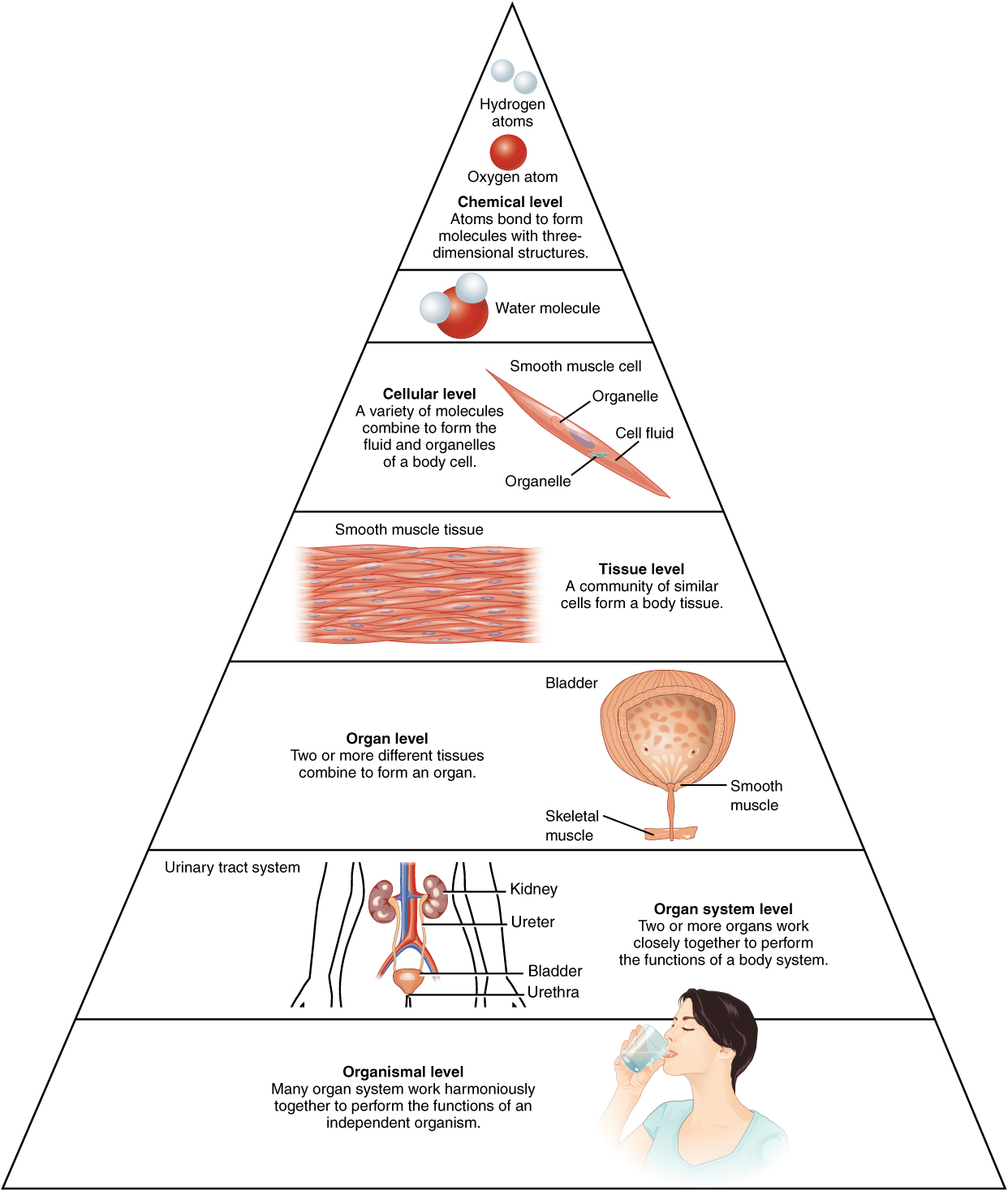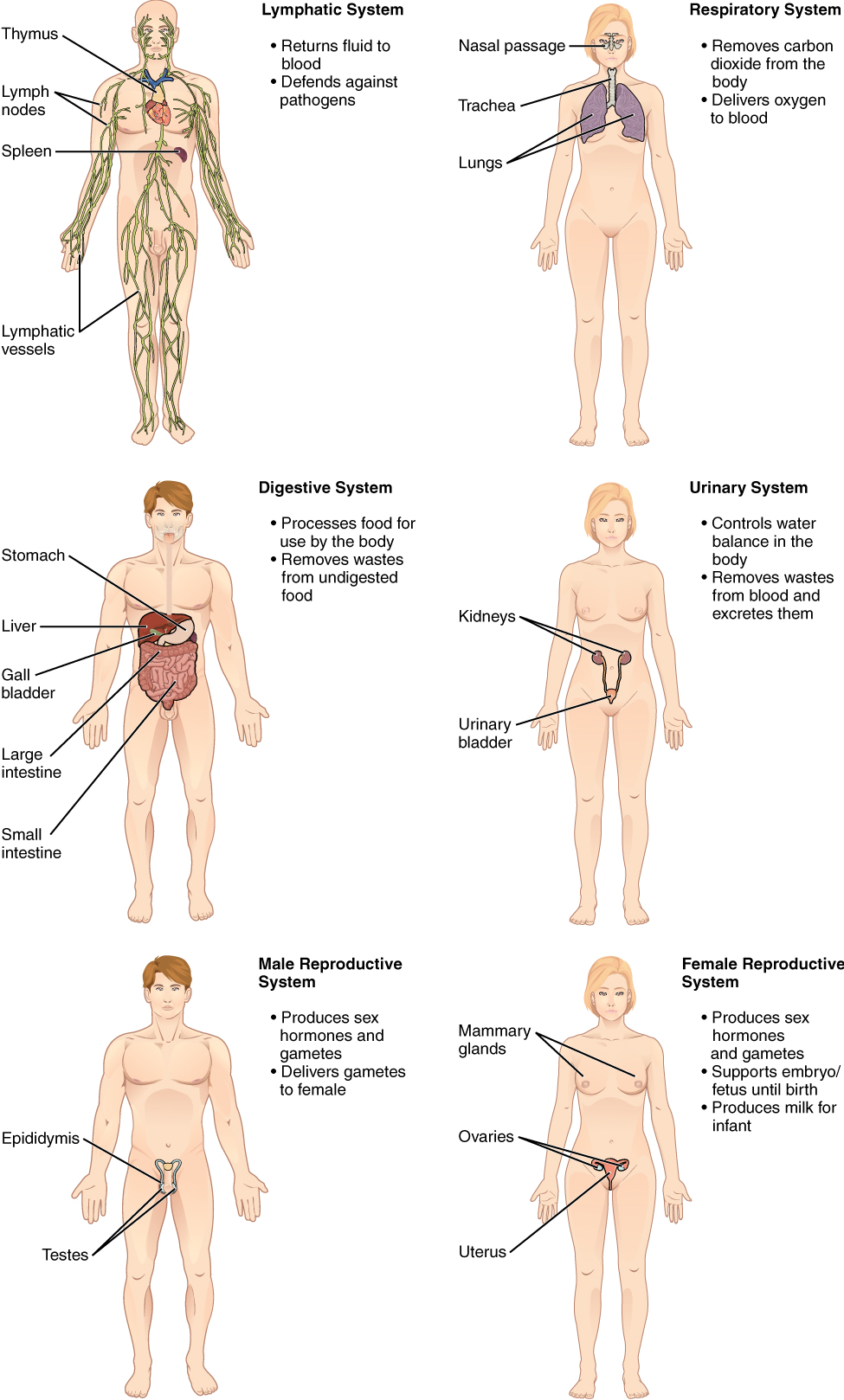Chapter 1
Introduction to Human Biology and the Scientific Process
1.1 Structural Organization of the Human Body
Objectives
By the end of this section, you will be able to:
-
Describe the structure of the human body in terms of six levels of organization
-
List the eleven organ systems of the human body and identify at least one organ and one major function of each
Before you begin to study the different structures and functions of the human body, it is helpful to consider its basic architecture; that is, how its smallest parts are assembled into larger structures. It is convenient to consider the structures of the body in terms of fundamental levels of organization that increase in complexity: subatomic particles (e.g. protons, neutrons, and electrons), atoms, molecules, macromolecules (e.g. carbohydrates, lipids, proteins, and nucleic acids) organelles, cells, tissues, organs, organ systems, and organisms (Figure 1.2)
The Levels of Organization
To study the chemical level of organization, scientists consider the simplest building blocks of matter: subatomic particles, atoms and molecules. All matter in the universe is composed of one or more unique pure substances called elements, familiar examples of which are hydrogen, oxygen, carbon, nitrogen, calcium, and iron. The smallest unit of any of these pure substances (elements) is an atom. Atoms are made up of subatomic particles such as the proton, electron and neutron. Two or more atoms combine to form a molecule, such as the water molecules, proteins, and sugars found in living things. Molecules are the chemical building blocks of all body structures.

A cell is the smallest independently functioning unit of a living organism. Even bacteria, which are extremely small, independently-living organisms, have a cellular structure. Each bacterium is a single cell. All living structures of human anatomy contain cells, and almost all functions of human physiology are performed in cells or are initiated by cells.
A human cell typically consists of flexible membranes that enclose cytoplasm, a water-based cellular fluid together with a variety of tiny functioning units called organelles. In humans, as in all organisms, cells perform all functions of life. A tissue is a group of many similar cells (though sometimes composed of a few related types) that work together to perform a specific function. An organ is an anatomically distinct structure of the body composed of two or more tissue types. Each organ performs one or more specific physiological functions. An organ system is a group of organs that work together to perform major functions or meet physiological needs of the body.
Figure 1.3 shows the eleven distinct organ systems in the human body. Assigning organs to organ systems can be imprecise since organs that “belong” to one system can also have functions integral to another system. In fact, most organs contribute to more than one system. In this course, we will discuss some, but not all, of these organ systems.
The organism level is the highest level of organization. An organism is a living being that has a cellular structure and that can independently perform all physiologic functions necessary for life. In multicellular organisms, including humans, all cells, tissues, organs, and organ systems of the body work together to maintain the life and health of the organism.
Section Summary
Life processes of the human body are maintained at several levels of structural organization. These include the chemical, cellular, tissue, organ, organ system, and the organism level. Higher levels of organization are built from lower levels. Therefore, subatomic particles combine to produce atoms, atoms combine to produce molecules, molecules combine to produce macromolecules, macromolecules contribute to the formation of organelles which combine to form cells, cells combine to form tissues, tissues combine to form organs, organs combine to form organ systems, and organ systems combine to form organisms.
Key Terms
- cell
- smallest independently functioning unit of all organisms; in animals, a cell contains cytoplasm, composed of fluid and organelles
- organ
- functionally distinct structure composed of two or more types of tissues
- organ system
- group of organs that work together to carry out a particular function
- organism
- living being that has a cellular structure and that can independently perform all physiologic functions necessary for life
- tissue
- group of similar or closely related cells that act together to perform a specific function


